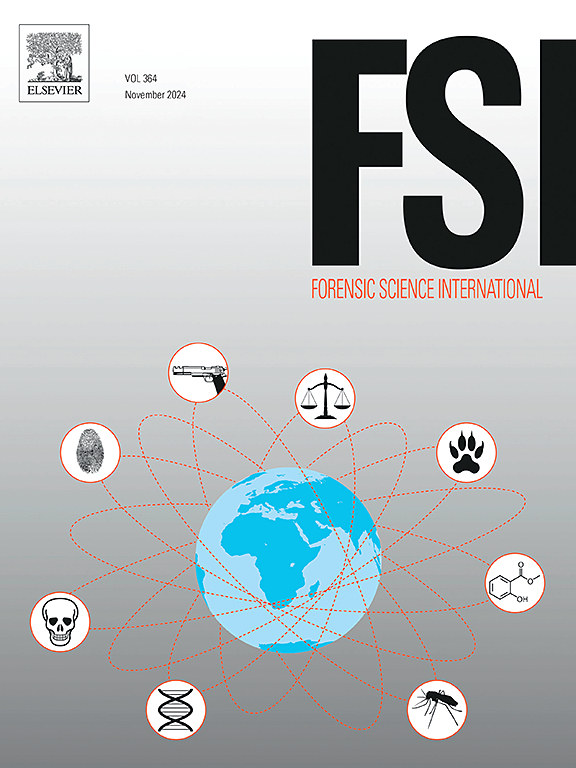GHB的死后形成:法医尸检的回顾性研究
IF 2.2
3区 医学
Q1 MEDICINE, LEGAL
引用次数: 0
摘要
目的:研究不同GHB血药浓度下死后GHB形成的情况,GHB死后形成的尿/血比,以及乙醇与GHB共同形成的频率。方法纳入525例血、尿GHB浓度高于31.2 mg/L的患者。研究结果与挪威死因登记处相关联。我们将尿液和血液中GHB浓度的比值设置为2以下,作为死后GHB形成的指标,并使用有关官方死亡原因的数据来验证分类。死后形成的乙醇被定义为阳性乙醇结合阴性硫酸乙酯(EtS)结果。结果在所有GHB阳性病例中,85% %被定义为死后形成,中位尿/血比为0.52。大多数GHB浓度较低,但30% %的病例GHB血药浓度高于约50 mg/L (500 μmol/L)。在尿/血比高于2的病例中,怀疑摄入了GHB,其中15% %的患者血液中GHB浓度低于约50 mg/L。在27% %的死后形成的GHB病例中发现乙醇共形成。在死后形成GHB和乙醇的情况下,死后间隔(PMI)明显更长。结论死后病例中ghb最常在死亡后形成,且浓度主要在较低水平,但不限于较低水平。大约30% %的病例会发生乙醇的共同形成,并且增加PMI会增加死后GHB和乙醇形成的频率。本文章由计算机程序翻译,如有差异,请以英文原文为准。
Post-mortem formation of GHB: A retrospective study of forensic autopsies
Aims
The aims were to investigate the occurrence of post-mortem formation of gammahydroxybutyrate (GHB) at different GHB blood concentration levels, the urine/blood ratios seen after post-mortem formation of GHB, and how often ethanol was co-formed with GHB.
Methods
Our study includes 525 cases with GHB concentrations above 31.2 mg/L in blood and urine. The results were linked to the Norwegian Cause of Death Registry. We set a ratio below two between urine and blood GHB concentration as indicator for postmortem formation of GHB, and used data regarding official causes of death to verify the classification. Post-mortem formed ethanol was defined as positive ethanol combined with negative ethyl sulfate (EtS) results.
Results
Of all GHB positive cases, 85 % were defined as post-mortem formation, with a median urine/blood ratio of 0.52. The majority were lower concentrations, but 30 % of the cases showed GHB blood concentrations above approximately 50 mg/L (500 μmol/L). In the cases with urine/blood ratio above two, intake of GHB was suspected, and 15 % of these had GHB concentration in blood below approximately 50 mg/L. Co-formation of ethanol was seen in 27 % of cases with post-mortem formed GHB. The post-mortem interval (PMI) was significantly longer in cases with post-mortem formed GHB and ethanol.
Conclusions
GHB in post-mortem cases is most commonly formed after death, and concentrations are mainly, but not exclusively, in lower levels. Co-formation of ethanol occurs in about 30 % of cases, and increasing PMI increase the frequency of post-mortem formation of GHB and ethanol.
求助全文
通过发布文献求助,成功后即可免费获取论文全文。
去求助
来源期刊

Forensic science international
医学-医学:法
CiteScore
5.00
自引率
9.10%
发文量
285
审稿时长
49 days
期刊介绍:
Forensic Science International is the flagship journal in the prestigious Forensic Science International family, publishing the most innovative, cutting-edge, and influential contributions across the forensic sciences. Fields include: forensic pathology and histochemistry, chemistry, biochemistry and toxicology, biology, serology, odontology, psychiatry, anthropology, digital forensics, the physical sciences, firearms, and document examination, as well as investigations of value to public health in its broadest sense, and the important marginal area where science and medicine interact with the law.
The journal publishes:
Case Reports
Commentaries
Letters to the Editor
Original Research Papers (Regular Papers)
Rapid Communications
Review Articles
Technical Notes.
 求助内容:
求助内容: 应助结果提醒方式:
应助结果提醒方式:


